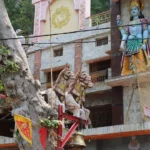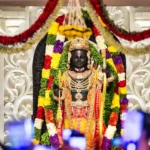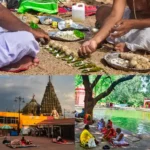Historical Significance of Hanuman Garhi Ayodhya
The Dawn of Devotion: A 10th Century Genesis
Hanuman Garhi’s roots can be traced back to the 10th century, marking it as one of the most ancient and significant temples in the Ayodhya region.
This temple, dedicated to Lord Hanuman, is not just a religious site but a living chronicle of India’s rich spiritual history. The temple’s inception during this era signifies its longstanding presence in the tapestry of Hindu worship and mythology.
The Patronage of the Rulers: A Story of Support and Preservation
The temple’s history is intertwined with the narratives of various rulers who contributed to its establishment and upkeep. Notably, during the 18th century, the land for Hanuman Garhi was first allotted to Abhayaram Das. This period was marked by the governance of Saadat Khan (1722–1739 CE), under whose auspices the temple began to gain prominence.
Subsequent rulers, including Safdarjung and Shuja-ud-daulah, continued to support the temple by granting additional revenue land, illustrating the historical recognition and reverence the temple commanded. The temple’s completion was finally realized under Diwan Tikait Rai during Asaf-ud-daulah’s governorship in 1799 CE.
The Strategic and Cultural Epicenter – Hanuman Garhi Ayodhya
Positioned in proximity to the Ram Janmabhoomi, Hanuman Garhi has not just been a center of devotion but also a strategic point of significance throughout history. In 1855, the temple was protected from Sunni attackers by the Nawab of Awadh, a pivotal event that underscored the temple’s cultural and communal importance.
Notably, historian Sarvepalli Gopal has remarked that the dispute during this period was specifically for the Hanuman Garhi temple, highlighting its central role in the historical and religious landscape of Ayodhya.
A Symbol of Resilience and Continuity – Hanuman Garhi Ayodhya
Through centuries, Hanuman Garhi has stood as a symbol of resilience, withstanding the test of time and evolving political landscapes. It has continued to be a beacon of the Hindu faith, drawing innumerable devotees who seek solace and strength from the revered deity, Lord Hanuman.

The temple’s historical journey from its inception to its current status as a major pilgrimage site encapsulates a saga of devotion, patronage, and cultural significance.
This rich historical backdrop sets the stage for understanding Hanuman Garhi’s architectural grandeur, religious practices, and the significance it holds in the hearts of its devotees. As we delve deeper into the architectural marvels of the temple in the next section, the tapestry of history and devotion woven around Hanuman Garhi becomes even more vivid and inspiring.
Architecture and Structure of Hanuman Garhi Ayodhya
The Architectural Grandeur: A Fort-Like Temple
Hanuman Garhi, with its distinctive architecture, stands as a hallmark of divine craftsmanship. Resembling a four-sided fort, it showcases the unique blend of religious and military architecture, a feature not commonly seen in Hindu temples. The temple’s design with circular bastions at each corner symbolizes strength and protection, reflecting the qualities of Lord Hanuman himself. The formidable appearance of the temple fortifies its position as a guardian of faith and history within Ayodhya.
Ascending to Devotion: The Stairway to the Divine
A significant architectural element of Hanuman Garhi is the 76 steps that lead to the main temple complex. These stairs are not just a physical path but a metaphorical journey for devotees, symbolizing the ascension towards spiritual enlightenment and closeness to the deity. Climbing these steps is considered an act of devotion, preparing pilgrims for the divine experience awaiting them at the summit.
The Inner Sanctum: A Cave of Divine Presences – Hanuman Garhi Ayodhya
The main temple houses an interior cave, adorned with numerous statues of Lord Hanuman and his mother, Maa Anjani. This setup provides a unique devotional experience, as devotees are surrounded by representations of the deity, enhancing their spiritual connection. The use of caves in temple architecture is significant, symbolizing depth, introspection, and the inner journey of a devotee.
A Blend of Aesthetics and Symbolism – Hanuman Garhi Ayodhya
The temple’s Nagara style of architecture, prevalent in northern India, is characterized by its beehive-shaped shikhara (tower). This style is not just aesthetically pleasing but also holds symbolic meaning, representing the ascent to heaven and the spiritual journey of the devotee. The colourful temple structure, adorned with intricate carvings and embellishments, is a sight to behold, capturing the essence of Hindu temple artistry.
The Vibrant Entrance and the Victory Pillar – Hanuman Garhi Ayodhya
The entrance of Hanuman Garhi is marked by colourful pillars, creating an inviting and vibrant atmosphere. A notable feature within the temple is the Vijay Stambha (Victory Pillar), believed to have been brought by Lord Hanuman from Lanka. This pillar stands as a symbol of victory and the fulfilment of desires, drawing devotees who pray here seeking blessings for their aspirations.

The architectural design of Hanuman Garhi is not only a feast for the eyes but also a representation of deep spiritual and symbolic meanings. Each aspect of its structure, from the imposing stairs to the intricate carvings and the sacred inner sanctum, tells a story of devotion, strength, and divine presence. In the next section, we will explore the religious significance and practices that breathe life into this architectural marvel.
Religious Significance and Practices at Hanuman Garhi Ayodhya
The Spiritual Abode of Lord Hanuman
Hanuman Garhi, more than just an architectural marvel, is a living embodiment of Hindu spiritual traditions. It is revered as a significant centre of worship dedicated to Lord Hanuman, a paramount figure in Hindu mythology known for his unwavering devotion to Lord Rama. This temple serves as a potent symbol of faith, embodying Hanuman’s role as a protector and devotee.
The Daily Rituals: A Testament to Time-Honored Traditions
The temple follows a rigorous schedule of daily rituals, which are integral to its religious practices. One of the unique aspects of Hanuman Garhi is the belief that Lord Hanuman himself oversees the rituals. It’s said that if there’s any lapse in the service of the deities, the head priest is reminded by Lord Hanuman within two hours about the mistake in worship, highlighting the deep connection between the deity and the temple practices.
Every evening, a special ritual takes place where the pujari (priest) prepares the simhasan (royal seat) for Lord Hanuman, bedecking it completely with flowers. This practice is a symbol of reverence and honour to the deity, embodying the temple’s dedication to upholding the sanctity of worship.
Festivals: Celebrations of Devotion and Joy
Hanuman Garhi becomes a hub of vibrant festivities during significant Hindu festivals. Rama Navami, Hanuman Jayanthi, and Diwali are celebrated with great fervour, attracting devotees in large numbers. These festivals not only mark important events in the Hindu calendar but also serve as occasions for communal harmony and spiritual rejuvenation. The temple’s atmosphere during these times is electric, filled with devotional songs, rituals, and the collective spirit of the devotees.
The Darshan Experience: A Journey of Faith
For devotees, visiting Hanuman Garhi is more than a religious obligation; it’s a journey of faith. The darshan (the act of seeing the deity) at this temple is considered especially auspicious. Devotees often engage in pradakshina (circumambulation) around the deity after darshan, a practice believed to bring blessings and fulfil desires.

The temple’s spacious design accommodates a large number of devotees, ensuring a serene and orderly darshan experience.
The Symbolism in Worship – Hanuman Garhi Ayodhya
At Hanuman Garhi, worship goes beyond mere rituals; it symbolizes the deep-seated devotion and strength that Lord Hanuman represents. The temple, with its daily rituals and festive celebrations, serves as a constant reminder of the virtues of devotion, strength, and loyalty in Hinduism. It is a place where devotees not only pay homage to Lord Hanuman but also seek inspiration to imbibe these virtues in their own lives.
In conclusion, Hanuman Garhi stands as a beacon of Hindu spirituality, offering a profound experience of devotion and tradition. Its significance in the religious landscape of Ayodhya is unparalleled, making it a must-visit for those seeking spiritual enlightenment and cultural immersion.






























